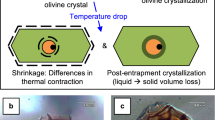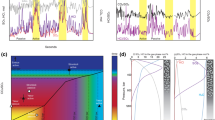Abstract
Lava fountains are spectacular continuous gas jets, propelling lava fragments to heights of several hundred metres, which occasionally occur during eruptions of low-viscosity magmas1,2,3,4,5. Whether they are generated by the effervescent disruption of fast-rising bubbly melt2,3,4,5 or by the separate ascent of a bubble foam layer accumulated at depth6,7 still remains a matter of debate8. No field measurement has yet allowed firm discrimination between these two models. A key insight into the origin of lava fountains may be gained by measuring the chemical composition of the driving gas phase. This composition should differ markedly depending on whether the magma degassing occurs before or during eruption9,10. Here we report the analysis of magmatic gas during a powerful (250–600 m high) lava fountain, measured with Fourier transform infrared spectroscopy11,12,13,14 on Mount Etna, Sicily. The abundances of volcanic gas species, determined from absorption spectra of lava radiation, reveal a fountain gas having higher CO2/S and S/Cl ratios than other etnean emissions14,15,16,17,18, and which cannot derive from syn-eruptive bulk degassing of Etna basalt19,20. Instead, its composition suggests violent emptying of a gas bubble layer previously accumulated at about 1.5 km depth below the erupting crater.
This is a preview of subscription content, access via your institution
Access options
Subscribe to this journal
Receive 51 print issues and online access
$199.00 per year
only $3.90 per issue
Buy this article
- Purchase on Springer Link
- Instant access to full article PDF
Prices may be subject to local taxes which are calculated during checkout



Similar content being viewed by others
References
Swanson, D. A., Duffield, W. A., Jackson, D. B. & Peterson, D. B. Chronological narrative of the 1969–1971 Mauna Ulu eruption of Kilauea volcano, Hawaii. US Geol. Surv. Prof. Pap. 1056, 1–59 (1979)
Wilson, L. & Head, J. W. Ascent and eruption of basaltic magma on the Earth and Moon. J. Geophys. Res. 86, 2971–3001 (1981)
Head, J. W. & Wilson, L. Lava fountain heights at Pu'u'O'o, Kilauea, Hawaii: indicators of amount and variations of exsolved magma volatiles. J. Geophys. Res. 92, 13715–13719 (1987)
Sparks, R. S. J. The dynamics of bubble formation and growth in magmas. J. Volcanol. Geotherm. Res. 3, 1–37 (1978)
Parfitt, E. A., Wilson, L. & Neal, C. A. Factors influencing the height of Hawaiian lava fountains: implications for the use of fountain height as an indicator of magma gas content. Bull. Volcanol. 57, 440–450 (1995)
Jaupart, C. & Vergniolle, S. Laboratory models of Hawaiian and Strombolian eruptions. Nature 331, 58–60 (1988)
Vergniolle, S. & Jaupart, C. Dynamics of degassing at Kilauea volcano, Hawaii. J. Geophys. Res. 95, 2793–2809 (1990)
Parfitt, E. A. A discussion of the mechanisms of explosive basaltic eruptions. J. Volcanol. Geotherm. Res. 134, 131–144 (2004)
Gerlach, T. M. Exsolution of H2O, CO2, and S during eruptive episodes at Kilauea Volcano, Hawaii. J. Geophys. Res. 91, 12177–12185 (1986)
Giggenbach, W. F. In Monitoring and Mitigation of Volcano Hazards (eds Scarpa, R. & Tilling, R.) (Springer, Berlin, 1996)
Mori, T. et al. Remote detection of fumarolic gas chemistry at Vulcano, Italy, using an FT-IR spectral radiometer. Earth Planet. Sci. Lett 134, 219–224 (1995)
Francis, P. W., Burton, M. & Oppenheimer, C. Remote measurements of volcanic gas compositions by solar FTIR spectroscopy. Nature 396, 567–570 (1998)
Burton, M., Oppenheimer, C., Horrocks, L. A. & Francis, P. W. Field measurement of CO2 and H2O emissions from Masaya Volcano, Nicaragua, by Fourier transform spectrometry. Geology 28, 915–918 (2000)
Burton, M., Allard, P., Murè, F. & Oppenheimer, C. In Volcanic Degassing (eds Oppenheimer, C., Pyle, D. & Barclay, J.) 281–293 (Special Publication 2213, Geological Society, London, 2003)
Allard, P. Géochimie Isotopique et Origine de l'eau, du Carbone et du Soufre dans les Gaz Volcaniques: Zones de Rift, Marges Continentales et Arcs Insulaires. Thesis, Paris 7 Univ. (1986)
Allard, P. et al. Eruptive and diffuse emissions of carbon dioxide from Etna volcano. Nature 351, 387–391 (1991)
Pennisi, M. & Le Cloarec, M. F. Variations of Cl, F, and S in Mount Etna's plume, Italy, between 1992 and 1995. J. Geophys. Res. B 103, 5061–5070 (1998)
Allard, P. Monitoring Volcanic Risk by Remote Sensing Techniques: Airborne Plume Validation (Final Rep. MVRRS RTD Contract, ENV4960288, CEE-DGXII, Bruxelles, 1999).
Métrich, N., Allard, P., Spilliaert, N., Andronico, D. & Burton, M. 2001 flank eruption of the alkali- and volatile-rich primitive melt responsible for Mount Etna's evolution in the last three decades. Earth Planet. Sci. Lett. 228, 1–17 (2004)
Spilliaert, N., Allard, P., Métrich, N. & Sobolev, A. A new step in modelling magma degassing processes and eruptive dynamics at Mount Etna: the 2002–2003 eruption. Geophys. Res. Abstr. 6, 04189 (2004)
Alparone, S., Andronico, D., Lodato, L. & Sgroi, T. Relationship between tremor and volcanic activity during the Southeast Crater eruption on Mount Etna in early 2000. J. Geophys. Res. 108, 2241, doi:10.1029/2002JB001866 (2003)
Allard, P. et al. Source process of cyclic fire fountaining at Mt. Etna in 2000: a multidisciplinary study of the June 14 (63rd) event. Geophys. Res. Abstr. 5, 13079 (2003)
World Data Centre for Greenhouse Gases, Japan Meteorological Agency. http://gaw.kishou.go.jp/wdcgg.html.
Métrich, N. & Clocchiatti, R. Sulfur abundance and its speciation in oxidized alkaline melts. Geochim. Cosmochim. Acta 60, 4151–4160 (1996)
Naughton, J. J., Derby, J. V. & Glover, R. B. Infrared measurements on volcanic gas and fume: Kilauea eruption, 1968. J. Geophys. Res. 74, 3273–3277 (1969)
Métrich, N., Clocchiatti, R., Mosbah, M. & Chaussidon, M. The 1989–1990 activity of Etna magma mingling and ascent of H2O-Cl-S-rich basaltic magma. Evidence from melt inclusions. J. Volcanol. Geotherm. Res. 59, 131–144 (1993)
Allard, P., Burton, M., Brusca, L. & Murè, F. Geochemical Monitoring of Sicilian Volcanoes (Second Rep., July-December 2000, Sistema Poseidon, Nicolosi, Italy, 2000).
Rodgers, C. D. Retrieval of atmospheric temperature and composition from remote measurements of thermal radiation. Rev. Geophys. Space Phys. 14, 609–624 (1976)
Rothman, L. S. et al. The HITRAN molecular spectroscopic database and HAWKS (HITRAN Atmospheric Workstation): 1996 edition. J. Quant. Spectrosc. Radiat. Transfer 60, 665–710 (1998)
Acknowledgements
We thank F. Barberi and L. Villari for their initial support of the Etna FTIR monitoring project within the Poseidon System (Italian Civil Defence and Sicily Region), and A. Bonaccorso, E. Boschi and S. Calvari for their continued support within INGV. We acknowledge early technical assistance from the Bruker company (Germany) and discussions with N. Métrich (LPS) and our colleagues in INGV-Catania.
Author information
Authors and Affiliations
Corresponding author
Ethics declarations
Competing interests
The authors declare that they have no competing financial interests.
Rights and permissions
About this article
Cite this article
Allard, P., Burton, M. & Muré, F. Spectroscopic evidence for a lava fountain driven by previously accumulated magmatic gas. Nature 433, 407–410 (2005). https://doi.org/10.1038/nature03246
Received:
Accepted:
Issue Date:
DOI: https://doi.org/10.1038/nature03246
This article is cited by
-
Assessing impending hazards from summit eruptions: the new probabilistic map for lava flow inundation at Mt. Etna
Scientific Reports (2023)
-
Near-surface magma flow instability drives cyclic lava fountaining at Fagradalsfjall, Iceland
Nature Communications (2023)
-
Exceptional eruptive CO2 emissions from intra-plate alkaline magmatism in the Canary volcanic archipelago
Communications Earth & Environment (2023)
-
Infrasonic gliding reflects a rising magma column at Mount Etna (Italy)
Scientific Reports (2022)
-
The volcanic activity changes occurred in the 2021–2022 at Vulcano island (Italy), inferred by the abrupt variations of soil CO2 output
Scientific Reports (2022)
Comments
By submitting a comment you agree to abide by our Terms and Community Guidelines. If you find something abusive or that does not comply with our terms or guidelines please flag it as inappropriate.



